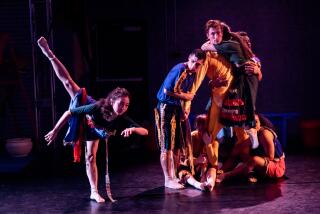Going to Extremes Focuses Wim Vandekeybus’ Work : Dance: The Belgian choreographer’s Ultima Vez company is among the most heralded on the experimental scene. It makes its L.A. debut today.
- Share via
Three women stand spread-eagled with their arms outstretched, brittle tension emanating from their faces and limbs. Almost immediately, male partners begin to frisk each one of them, searching every inch of the women’s bodies with a mix of cold detachment and manic fervor.
The women respond. One caresses her inquisitor, one fends off the contact with knife-like movements, and the last flies into a angry frenzy.
This is the world of Belgian choreographer Wim Vandekeybus. Harsh, emotional, erotic and confrontational, his dance/theater is among the most heralded on the experimental scene today.
A two-time Bessie Award winner at only 28, Vandekeybus and his company Ultima Vez make their Los Angeles debut today and Saturday at Occidental College’s Keck Theater, brought to town by the Dance Gallery.
On the bill is the American premiere of Vandekeybus’ most recent full-length piece, “Always the Same Lies,” a collage of dance, film and text inspired by the choreographer’s friendship with an 88-year-old acquaintance. The dance features a soundtrack by Belgian Peter Vermeersch and his jazz-rock band X-Legged Sally, with additional vocals by Charo Calvo.
Besides dozens of brown eggs that the dancers toss around stage and other unusual props, “Always the Same Lies” features Vandekeybus’ trademark penchant for psychological provocation and physical jeopardy.
“I don’t think the danger is the first thing I look for,” says Vandekeybus, speaking by phone from Canada where Ultima Vez performed earlier this week. “I put people in delicate situations and I push the energy, the desire to put yourself in danger.”
Somewhat of a departure from this repertoire of peril, “Always the Same Lies” has what Vandekeybus describes as “more tenderness and waiting time” than his other dance/theater pieces. Still, the choreographer “continues the language (of my) previous plays.”
It is a universe where women and men of an array of nationalities hurl cinder blocks across the stage at one another’s heads, fling themselves at each other in bursts of sadomasochistic energy or leap convulsively to their feet to relate bizarre story fragments.
It’s all part of the logic of the moment, as simple ritual underscores the intense emotions of human encounters. “If you work with extreme situations, the motion gets more focused,” says Vandekeybus. “It’s more important than the perfect performance.
“My main inspiration is that it’s difficult to work against instinct. It can be dangerous, (relying) on intuition rather than technique.”
As much avant-garde theater as dance, the violent movement and melodrama of Vandekeybus’ style has an affinity with the work of such international companies as Canada’s La La La Human Steps, seen here during the 1987 Los Angeles Festival, and Germany’s Pina Bausch Wuppertaler Tanztheater, which performed here at the 1984 Olympic Arts Festival.
As with these artists, Vandekeybus uses elemental scenarios to provoke complex responses. “I make studies with weight and balance,” he says. “But in the end, I go to instinct--with people falling, objects in space, conflict. I like people to have to do something concrete, to see how people work. Catastrophical imagination is very important for dancers.”
As for the state of dance in general, Vandekeybus doesn’t mince words. “I go to very few performances now,” he says, although he admits a fondness for New York’s avant-garde theater company the Wooster Group. “Dance itself is very boring. I don’t like to work with abstract forms of dance.”
Instead, Vandekeybus--who is also an actor, photographer and longtime equestrian--finds the inspiration for his choreography in other activities. “The fact that I’ve been riding horses can be more important than that I went to see this dance or that dance,” he says. “I start with animal energy--say, a run and a jump--and see what will happen.”
The tension of that split-second before a horse decides to take a hurdle or to balk, Vandekeybus says, is what he tries to re-create in his choreography. “This unexpected moment where you never know what will happen is exciting to me. They can stop at the last moment. Like dance, it’s based on perfect control.”
More to Read
The biggest entertainment stories
Get our big stories about Hollywood, film, television, music, arts, culture and more right in your inbox as soon as they publish.
You may occasionally receive promotional content from the Los Angeles Times.










